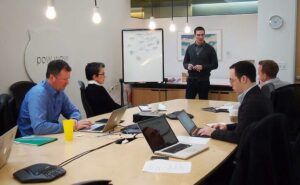With so many note taking strategies out there, how do you choose the right one for you?
Some people call effective note taking an art. While I don’t disagree, there’s usually significant rigor and process (the “science”) behind the practice of the world’s best artists.
Note taking is no different; what may look like art is often the manifestation of deeply-rooted practices refined by time and repetition. I was recently asked by a mentee what are my note taking strategies, which led to breaking down my approach in a systematic fashion. Now I’d like to share that system with you!
In this article, I’ll be covering:
- The Biggest Problem Preventing You From Taking Good Note
- Which Items To Write Down And Which To Avoid When Taking Notes During Meetings
- How To Refine Your Note Taking Strategies For More Efficient Notes
- Tips And Tricks To Constantly Keep In Mind
Let’s begin by tackling the big problem with note-taking.
What makes note taking so difficult?
It’s important to start by identifying my most common note scenario for some context: taking notes as a project manager in a group meeting, whether on a call with many stakeholders or in a planning session with your core team.
Often this setting requires that the project manager both lead the meeting and take notes at the same time. Those responsibilities require different skills and different parts of the brain; one role is presenting and managing the direction of the meeting (usually involving sharing information and knowledge along the way), while the other is actively listening, processing, documenting, and reacting.
Switching between those two roles while managing a planned agenda (and doing it well) can be a daunting challenge. The arguably more important of the two is leading the meeting, so creating note taking strategies that are compatible with continual context-switching is a must.
A Framework for Note Prioritization
The most detailed and in-depth notes often end up being nearly worthless given context in which they were taken. You’re not a court reporter whose job is to capture what was spoken word-for-word. In fact, please don’t; human speech is often somewhat incoherent when written down verbatim and makes you read an excessive amount of information to find the valuable bits.
When it comes to meeting notes, they’re really only useful if they can quickly be searched and skimmed later to find relevant information. Prioritization is key.
Most common reasons to be searching through old notes:
- Figuring out who is supposed to do what
- Revisiting/clarifying decisions made
- Looking for greater context on requirements
- Resolving disagreements/disputes (and to some extent, CYA)
So the key here is to use note taking strategies that suit your needs.
[Tweet “Notes are only useful if they can quickly be searched and skimmed later to find relevant information”]
What should you write down in your notes?
Must-Capture
- Action Items – If nothing else, capture action items (also known as to-dos, tasks, action requests, or by plenty of other terms in different organizations). These will serve as the foundation to keep everyone aligned and moving forward. I prefer a simple format: “[Person Name] to [specific task details] by [due date].”
- Decisions – Plenty of meetings get deep into the weeds of debate around features and approach. Much of that detail won’t be valuable later but clearly defining the outcome and decision agreed to by the group is essential.
- Requirements/Specifications – You’ll need to develop a spidey-sense for when requirements are coming during discussion. Sometimes they pop up unexpectedly in the midst of conversation. But obviously they’re important to document (and centralize rather than only keeping in notes) so you don’t have to revisit and re-discuss later.
Capture At Your Discretion
- Misc. Discussion Points – Use your best judgment when it comes to which discussion elements to capture. If your gut is that there may be some need to revisit later, better take the notes! If the discussion is around a topic that is already well-documented in requirements or not essential to the team’s knowledge, brevity is better.
- Opinions & Debate – Per the above, if a decision is made, capturing that decision is paramount; the discussion leading up to it? Maybe not so much. But if an issue is left undecided, it’s definitely worth jotting down the different items under consideration.
- Brainstorming – Again, outcomes and decisions are the most important elements of a brainstorm to capture, but there may be some value in capturing the details. If you’re whiteboarding, just take photos and add any contextual notes later!
- General Conversation – Much of the time capturing the conversation in detail won’t provide much value later. Instead, keep your ears open for action items, decisions, and requirements as they pop up.
Don’t Capture
- Ambiguous Viewpoints – Sometimes stakeholders will wind up debating themselves and going back or forth on their viewpoint while considering an issue. I’d suggest not capturing this and risking muddying the outcome (but definitely capture the outcome).
- Pleasantries – It’s always fun to compare who has the better weather at the moment, but for note taking purposes? Definitely not necessary!
Honing Your Note Taking Strategies
Now that we’ve covered the details of actual note capture, the bigger-picture process at play leading to successful notes is worth covering. There are a number of key things that I do (or often regret it if I skip), including:
- Creating an agenda – This is project management 101, but even the most experienced meeting leaders occasionally walk in underprepared. If you take the advance time to plan an agenda, you’ll be able to better control the pace of the meeting and plan for the likely key notetaking moments.
- Taking notes in advance – The great part about having an agenda is that it means you can start taking notes even before the meeting. Write your key discussion points to present in advance. It’d be silly to try to take notes on what you’re saying while talking!
- Preparing note-taking tool(s) – Having your notes tool ready to go, pre-formatted with agenda and contextual topics before the start of the meeting will reduce work during the meeting.
- Blocking 10 minutes before the meeting (especially for calls) – I could write an entirely separate blog post on voice and video-calling tools, but needless to say, being set up early and testing out AV equipment will reduce headaches and make sure you’re started on time. Having the full allotted time and being able to hear everyone will lead to a less rushed call, which means better notes.
- Blocking 10 minutes after the meeting – The discussion context will never be fresher in your memory than immediately after a meeting. Use this time to clean up your notes, reorganizing as necessary, adding details where there may be gaps, and deleting notes that didn’t turn out to have much value. Bonus: take a pass on your notes for requirements that should be abstracted to a centrally documented location. You have that, right?

The key to taking memorable notes is to take notes 10 minutes before and after meetings
Tips & Tricks For Your Note Taking Toolkit
Above are my general note taking strategies and approach for prioritization, but there are a number of other tricks that I employ for further efficiency and headache reduction:
- Take partial notes – Skip words, use keywords, write incomplete sentences. Then immediately follow up while you still have context to make it more human-readable.
- Take notes in context – Don’t overly rely on your default note taking strategies. If the meeting is a client design review using Invision, capture notes as comments in Invision. Or if you’re reviewing JIRA ticket progress, take notes as comments on the appropriate JIRA tickets. Or if you’re reviewing a Google Docs requirements document, take notes as comments on the Google Doc. Whatever project management software you are using. You get the idea!
- Record the really important ones – If you have to lead a workshop or a large meeting with too many complexities to expect to be successful taking notes, record the audio (and/or video). No one besides you will ever take the time to listen to the audio, but at least you’ll have a way to reconstruct the details of into appropriate documentation later.
- Google is your friend – When managing a project for a new platform you’re unfamiliar with, it’s inevitable that terms and acronyms will get thrown around you don’t understand. Take your best phonetic interpretation of what was said (assuming you didn’t pause and clarify the term during the meeting) and throw it into Google with any context available, and more often than not you’ll get your answer. If not, assuming your entire team didn’t have the same confused look on their face during the discussion topic, it’s likely one or more of them can explain the details that tripped you up.
Less is More
If you only take one thing away from this post, it’s that less is more when it comes to meeting notes! The longer I’ve taken notes, the more succinct they’ve generally become. Don’t get me wrong – having notes is crucial, and taking good notes is an important part of a healthy project. But my current definition of “good” notes embraces a very “less is more” mentality.
[Tweet “My current definition of “good” notes embraces a very “less is more” mentality.”]
Often an hour meeting has ten or less key topics and moments that are must-haves in the notes. Meetings can be messy (even with an agenda), but that doesn’t mean your notes need to be; find the signal in the noise!
What do you think?
What are your strategies for note taking?




